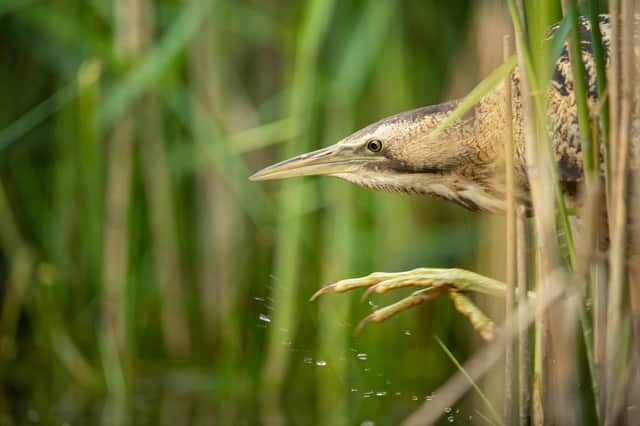RSPB: Brilliant year for 'booming' bitterns which have twice faced extinction - here's where you can hear them
and live on Freeview channel 276
Conservation efforts have paid off for a noisy and secretive wetland bird, which has twice stared down extinction in the UK.
New survey results from the Royal Society for the Protection of Birds (RSPB) and Natural England have recorded 234 male bitterns heard ‘booming’ in 2023, marking a 24% increase on just 5 years ago. On top of that, the birds were also recorded at 11 new sites, including new, custom-made habitat created at RSPB Leighton Moss and on the Isle of Sheppey.
Advertisement
Hide AdAdvertisement
Hide AdThought to be Britain’s loudest bird, bitterns are known for the bizarre booming sound males use to attract a mate - which can be heard up to three miles away in the spring. This is what is used to record them in surveys, as the birds are exceptionally skilled at camouflaging into their reedbed homes.
Although its UK conservation status is currently amber, bitterns have twice faced extinction in the UK, according to the RSPB. They first became extinct as a breeding species in the 1870s due to hunting for food and the draining of their wetland habitats for agriculture, but the species returned to Norfolk in the early 1900s. Unfortunately numbers continued to fall, with just 11 booming males counted across the country in 1997 - making the prospect of a second national extinction a real threat.


This week’s new survey results painted a very different picture. RSPB senior conservation scientist Simon Wotton said: “The success of this species is in no doubt thanks to conservation efforts by many dedicated organisations and landowners, including the volunteers who have helped to monitor bittern populations over the years.
“It is brilliant to see the hard work of staff and volunteers in managing specialist habitat for bitterns paying off, and with many RSPB nature reserves now acting as a safe haven for this incredible species, spring really is the time to get out and try to hear their famous boom.” As sea levels continued to rise due to climate change, many of the birds’ traditional coastal reedbed habitats would be threatened, he said, and new inland breeding sites would become an important refuge for bitterns and other wetland species.
Advertisement
Hide AdAdvertisement
Hide Ad“Restoring these habitats aren’t just important for nature’s sake, they are a win-win for climate and people too,” Mr Wotton added. “Wetlands help to reduce downstream flooding risk and lock up carbon from the atmosphere in the face of the nature and climate emergency.”
Managing and creating these wetland habitats has been vital to the bitterns’ recent success, including at sites like RSPB Leighton Moss. The Lancashire nature reserve has been working on rejuvenating its reedbeds for quite some time, and has created new habitats specifically managed with the species in mind. But it’s paid off, with the number of booming bitterns recorded jumping from six to nine in 2023.
Meanwhile, Great Bells Farm on the Isle of Sheppey - an Environment Agency project managed in partnership with the RSPB - had its very first booming bittern recorded, the conservation charity said, adding to the number of RSPB nature reserves that support the amber-listed species.
Where can I see (or hear) a bittern this spring?
While bitterns can occasionally be spotted moving among the reeds at the water’s edge seeking out fish, insects, and amphibians to eat, at this time of year it’s must easier to hear than see the clandestine birds.
Advertisement
Hide AdAdvertisement
Hide AdBitterns were once found across Scotland and Northern Ireland, and conservationists hope that they will eventually re-establish themselves there. For now, you can listen out for the species across England and Wales - with more than half of the UK’s bittern population able to be found on RSPB reserves.
These include:
- RSPB Leighton Moss, Lancashire
- RSPB Middleton Lakes, Staffordshire
- RSPB Old Moor, Yorkshire
- RSPB St Aidan’s Nature Park, Yorkshire
- RSPB Blacktoft Sands, Yorkshire
- RSPB Langford Lowfields, Nottinghamshire
- RSPB Ouse Fen, Cambridgeshire
- RSPB Minsmere, Suffolk
- RSPB Lakenheath Fen, Suffolk
- Avalon Marshes, Somerset – RSPB Ham Wall, Shapwick Heath, Westhay Moor
- Newport Wetlands, Newport
- RSPB Cors Ddyga, Anglesey
Amber Allott is NationalWorld’s environment and sustainability specialist, covering all things green - from climate to conservation. If you liked this article you can follow Amber on X (Twitter) here and sign up for the free daily NationalWorld Today newsletter here - with Amber bringing you the UK's most important, pressing, weird and wonderful environmental stories every Tuesday.
Comment Guidelines
National World encourages reader discussion on our stories. User feedback, insights and back-and-forth exchanges add a rich layer of context to reporting. Please review our Community Guidelines before commenting.
